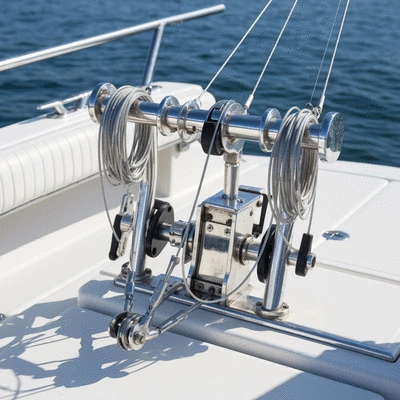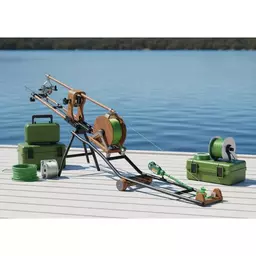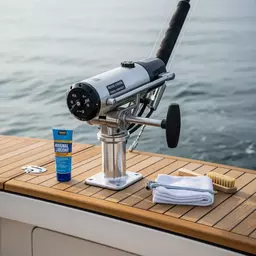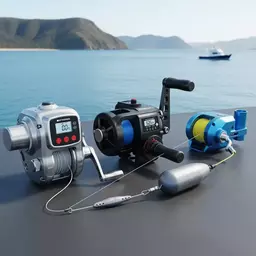Regular maintenance is the key to a successful fishing experience. By ensuring your downrigger is in top condition, you’ll maximize its performance and longevity. Let’s explore the essential insights you'll gain from understanding downrigger maintenance!
What You Will Learn
- Regular maintenance extends the lifespan of your downrigger and enhances its performance.
- A comprehensive checklist for monthly and seasonal tasks simplifies your maintenance routine.
- Using the right tools and cleaning solutions makes maintenance more effective and sustainable.
- Understanding common downrigger issues helps you troubleshoot problems to keep your fishing trips on track.
- Investing in quality replacement parts ensures optimal performance and reliability of your downrigger.
Downrigger Maintenance: A Step-by-Step Approach
This visual outlines the essential maintenance tasks for your downrigger, categorized by frequency and supported by the necessary tools and solutions.
Preventive Maintenance Checklists
Monthly Tasks:
- Inspect cables for frays or wear.
- Clean electrical connections.
- Lubricate moving parts.
Seasonal Tasks:
- Thoroughly clean entire downrigger.
- Test motor functions.
- Replace worn-out parts.
Essential Tools & Cleaning Solutions
Tools:
- Wrenches and Screwdrivers.
- Electrical tester.
Cleaning Solutions:
- Marine-grade soap.
- Corrosion inhibitors.
- Marine lubricants.
Understanding Downrigger Maintenance for Optimal Performance
As passionate anglers, we know how important it is to keep our gear in top condition. This is especially true for downriggers, which play a crucial role in our fishing success. Regular maintenance not only extends the lifespan of your downrigger but also ensures it operates effectively when it counts. Ignoring maintenance can lead to performance issues, which might result in missed catches or even equipment failures. For more detailed tips on keeping your equipment in prime condition, check out our guide on downrigger care tips for anglers.
By dedicating time to maintaining your downrigger, you're investing in your fishing adventures. A well-maintained downrigger can enhance your experience by providing reliable and efficient functionality, allowing you to focus on what truly matters: enjoying the great outdoors and reeling in that trophy fish!
The Importance of Regular Maintenance for Downriggers

Regular maintenance is essential for a few key reasons. First, it ensures that all components are functioning correctly, which includes checking for wear and tear on cables, motors, and other mechanical parts. Second, consistent upkeep helps to prevent larger issues from developing, saving you time and money in the long run!
- Longevity: Proper maintenance extends the life of your equipment.
- Performance: Maintaining your downrigger ensures optimal performance and reliability.
- Cost-Effective: Preventive measures can save you from costly repairs or replacements.
At Downrigger Insights, we believe in fostering a community of responsible fishers who value their equipment. Regular maintenance is a key part of that philosophy, allowing us all to enjoy the fruits of our fishing endeavors while protecting our investments.
Preventive Maintenance Checklists: A Step-by-Step Guide
To make your maintenance routine easier, I’ve put together a comprehensive checklist to follow. This includes both monthly and seasonal tasks, ensuring that you stay on top of your downrigger's needs throughout the year. For more insights on deep-sea fishing techniques that rely on well-maintained gear, explore our guide on downriggers for deep sea fishing.
- Monthly Tasks:
- Inspect cables for frays or wear.
- Check the downrigger's electrical connections and clean any corrosion.
- Lubricate moving parts to keep them functioning smoothly.
- Seasonal Tasks:
- Thoroughly clean the entire downrigger to remove salt and debris.
- Test motor functions and control boards to ensure reliability.
- Replace any worn-out parts, such as cables or weights.
This checklist not only helps keep your downrigger in great shape but also builds your confidence as an angler. Remember, the more prepared you are, the more successful your fishing trips will be!
Essential Tools and Cleaning Solutions for Downrigger Maintenance

Having the right tools and cleaning solutions at your disposal is vital for effective maintenance. Here are some essentials that I recommend for keeping your downrigger in peak performance.
- Tools:
- Wrenches for tightening bolts and screws.
- Screwdrivers for adjusting and repairing components.
- Electrical tester for checking connections.
- Cleaning Solutions:
- Marine-grade soap for safe cleaning.
- Corrosion inhibitors to protect electrical connections.
- Lubricants specifically designed for marine equipment.
Utilizing these tools and solutions not only enhances the performance of your downrigger but also contributes to a sustainable fishing practice, as you’re more likely to maintain your equipment and keep it in service longer.
Troubleshooting Common Downrigger Issues
Sometimes, despite our best efforts, issues can arise. But don’t worry! Understanding common problems with downriggers and how to troubleshoot them can keep your fishing trips on track. For solutions to common problems, refer to our common downrigger troubleshooting tips.
We Want to Hear From You!
As you think about your downrigger maintenance routine, we’d love to know: What maintenance tip has made the biggest difference in your fishing experience? Share your thoughts below!
Frequently Asked Questions About Downrigger Maintenance
Q1: Why is regular downrigger maintenance important?
Regular downrigger maintenance is crucial because it extends the lifespan of your equipment, ensures optimal performance, and helps prevent costly repairs or replacements. It allows you to catch issues early and keeps your downrigger reliable for every fishing trip.
Q2: What are the key monthly maintenance tasks for a downrigger?
Monthly tasks include inspecting cables for frays or wear, checking and cleaning electrical connections to prevent corrosion, and lubricating all moving parts to ensure smooth operation.
Q3: What seasonal maintenance should I perform on my downrigger?
Seasonal maintenance involves thoroughly cleaning the entire downrigger to remove salt and debris, testing motor functions and control boards for reliability, and replacing any worn-out parts like cables or weights.
Q4: What tools and cleaning solutions are essential for downrigger maintenance?
Essential tools include wrenches and screwdrivers for adjustments, and an electrical tester for checking connections. Recommended cleaning solutions are marine-grade soap, corrosion inhibitors for electrical components, and marine lubricants for moving parts.
Q5: How can I troubleshoot common downrigger issues?
Understanding common problems and their solutions is key to troubleshooting. This includes identifying issues with cable wear, electrical faults, or motor malfunctions. Addressing these promptly, often with the right tools and replacement parts, can keep your fishing trips on track.
Maximizing Your Downrigger's Lifespan Through Maintenance
At Downrigger Insights, we believe that keeping your downrigger in peak condition is essential for an enjoyable fishing experience. Regular maintenance not only extends the lifespan of your equipment but also enhances its effectiveness on the water. By taking the time to follow a maintenance routine, you can avoid costly repairs and ensure that your downrigger performs reliably every trip. Here are the key points we discussed regarding routine maintenance:
- Conduct regular inspections for wear and tear to catch issues early.
- Clean your downrigger after each fishing trip to remove salt, dirt, and debris.
- Follow a seasonal maintenance checklist to keep everything in top shape.
- Address any electrical or mechanical problems promptly to prevent further damage.
Each of these steps will go a long way toward maximizing your downrigger's lifespan. Remember, consistent care makes a world of difference, not only for your gear but for your fishing success!
Take Action: Ensuring Your Downrigger Is Ready for Action
Now that we've explored the importance of maintenance, it's time to take action! Implementing these maintenance steps will keep your downrigger ready for every fishing adventure. I encourage all anglers to consider the following:
- Set reminders for routine checks and cleaning schedules.
- Invest in quality parts and tools for maintenance tasks.
- Don’t hesitate to reach out for professional help when needed.
- Check out reputable suppliers for parts and accessories that can enhance your downrigger's performance.
By being proactive, you can ensure your downrigger is always ready to deliver the perfect bait at just the right depth. If you're unsure about any step of the process, I'm here to help guide you through it!
Evaluating Replacement Parts and Accessories for Enhanced Performance
When it comes to maintaining your downrigger, choosing the right replacement parts and accessories is crucial for optimizing performance and longevity. Here's what to keep in mind while evaluating your options:
- Opt for high-quality materials to resist wear and corrosion.
- Look for parts specifically designed for your downrigger model for a perfect fit.
- Consider accessories that enhance usability, like upgraded releases or more efficient cables.
By carefully selecting the right parts and accessories, you can significantly improve your downrigger's efficiency and reliability. Remember that a well-maintained downrigger is your best friend on the water, ensuring you're set for success every time you cast out!
Recap of Key Points
Here is a quick recap of the important points discussed in the article:
- Conduct regular inspections for wear and tear to catch issues early.
- Clean your downrigger after each fishing trip to remove salt, dirt, and debris.
- Follow a seasonal maintenance checklist to keep everything in top shape.
- Address any electrical or mechanical problems promptly to prevent further damage.
- Invest in quality parts and tools for maintenance tasks.
- Set reminders for routine checks and cleaning schedules.







